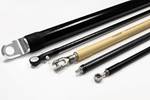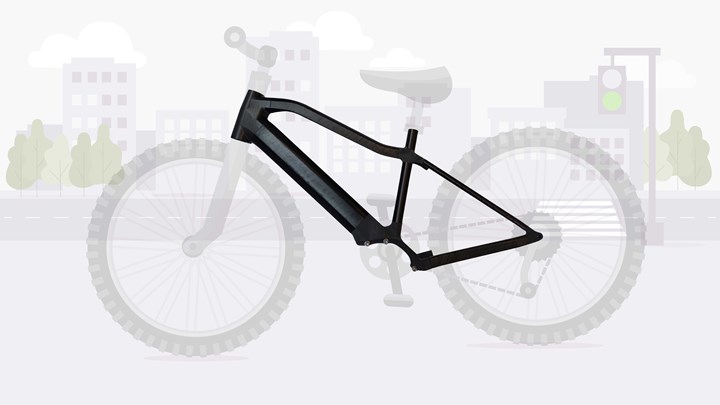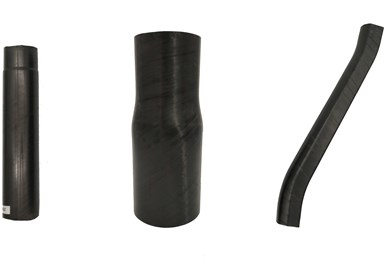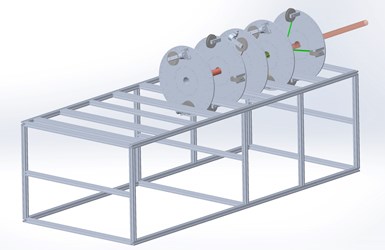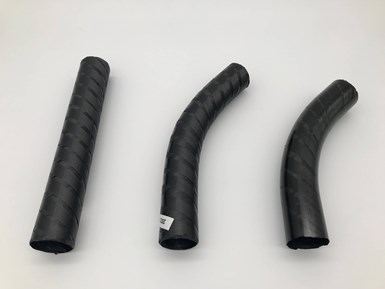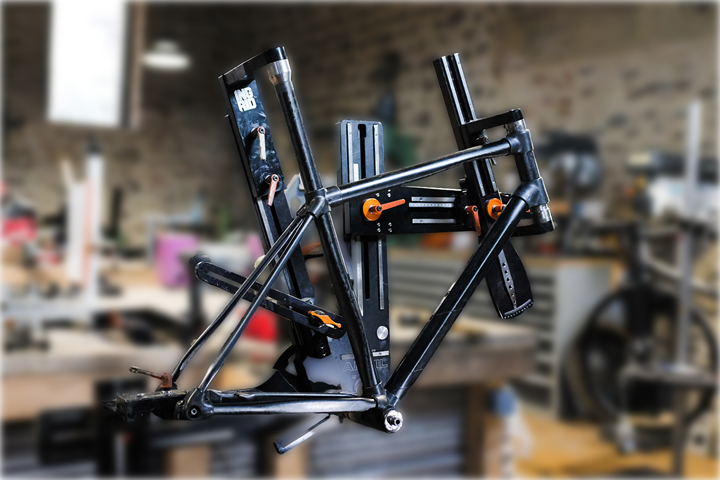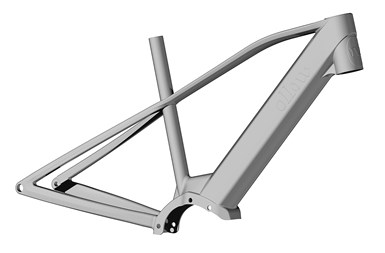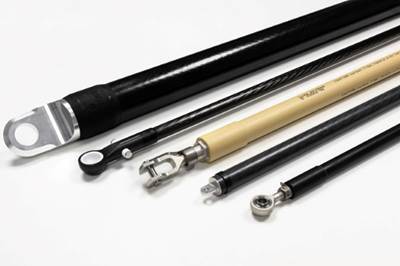Thermoplastic composite, tube-shaped preforms for large-volume manufacturing
Starting with the sporting goods and bicycle market, French startup 3DiTex targets its continuous preforming system for thermoformable, thermoplastic composite tubes in complex geometries.
Thermoplastic composite preforms for tubes, bicycle frames and beyond. French startup 3DiTex has developed a continuous process for winding complex-shaped, hollow, thermoformable preforms from thermoplastic composite tapes or other materials. The company’s first target market is sporting goods, including bicycle frame components and, soon, fully integrated bicycle frames like those shown here. Photo credit, all images: 3DiTex
High-volume manufacturing capability, easily recycled materials and design freedom are three increasingly important requirements for a material to be adopted for many end markets and applications, from high-performance sporting goods to commercial and defense aerospace parts.
3DiTex (Canéjan, France) is a startup company aiming to provide all three with its process for producing hollow, tube-shaped, thermoplastic composite preforms and end-use parts, with the ability to mold into complex shapes and be manufactured from easier-to-recycle thermoplastic or even bio-based materials as well as the potential for production in large volumes.
The company’s founders, Bertrand Laine and Aymeric Azran, earned Ph.D. degrees in materials science and the mechanics of materials, respectively, and worked for a number of years in composites and technical textiles. They met while working on 3D knitted preform technology at R&D company RT2i (since acquired by Saint-Gobain), and in 2016, decided to leverage their experience to found startup company Nobrak specializing in innovations related to tailored fiber placement (TFP) technology.
“When we started Nobrak, we modified an existing TFP machine and we made flat preforms that could then be stamp formed or put through some other process to form a more complex geometry,” says Laine. While the company has seen success with this technology, he adds that it was quickly apparent that one market gap Nobrak was not able to serve was the need for hollow, tube-shaped preforms common to many applications and end markets, from bicycle frames to aerospace struts. To fill this need, Laine and Azran began investigating methods to produce hollow preforms that could then be molded into tube-shaped composite parts.
The resulting technology is a continuous, modified winding process (more on this below) designed as a modular system for manufacturing highly material-optimized, tube-shaped thermoplastic composite preforms that can then be molded into final parts — including those with complex shapes and curves.
Laine and Azran leveraged this method into a second startup in 2018, 3DiTex. Today, Laine serves as CEO of 3DiTex, and Azran as CEO of Nobrak. In the last few years, 3DiTex has been raising funds, filing patents on its technology and has grown to a team of 32 employees. With plans to open its first official pilot line in 2024 and first production plant in 2025, the company is already using its initial pilot machine to produce prototype and commercial parts for customers.
The 3DiTex process
The 3DiTex system is, essentially, a continuous production line consisting of a series of winders laying down tapes or filaments onto a mandrel or support to manufacture the preform layer by layer as it is pulled through the system. The process is said to be something of a cross between a continuous pultrusion line and filament winding, combining the speed and continuous production of pultrusion with the ability to wind tapes or filaments in various orientations and angles.
One of the main innovations in the 3DiTex system is the way its winding process works to create a multilayer textile preform without the time-consuming, back-and-forth motion of a typical filament winding system. Laine explains, “The first point of the technology is to build preforms in a continuous way. That was the start. But of course other technologies can also do that, with braiding, for example. So then the challenge became how to lay down all of the layers at once. We also didn’t want to reinvent pultrusion. We wanted to be able to do complex geometries, and for the preform to be bendable to different shapes, not just straight profiles like you get with pultrusion.”
The resulting 3DiTex system is a series of winder modules — Laine calls them “discs,” referring to their round shape — that are mounted along a fixed mandrel or support structure onto which the filaments or tapes are wound. Each module works independently, positioned at equal distances along the system and programmed to rotate around the mandrel and deposit one specific layer. The preform moves continuously through the system at a specified speed, typically a meter or more per minute, with modules laying down successive layers. The modules are highly customizable, programmed to rotate at a specified speed and lay down the materials at a specified angle for each layer of each part.
Continuous winding. The 3DiTex process is said to combine the continuous production capability of pultrusion with the ability to wind tapes at optimal orientations and angles.
“Typically with winding, it’s a one-shot process with the winder going back and forth, right and left, over the support,” says Laine. “But in our case, it never goes back to the right, it just goes one way all the way through continuously, so each disk has to apply the full quantity of material that we want for each layer.”
Moving forward. Each disc-shaped winder along the line is programmed independently, laying down one material layer at a time while the preform moves continuously forward, eliminating the typical process of a filament winder going back and forth over a mandrel.
He adds that there are two options for the mandrel or support structures used in the 3DiTex system. “You can either push a mandrel — with the preform being formed on top of it — continuously through the system, or pull the preform itself, sliding along a fixed support.” This depends on the material used as the base preform.
The system operates via design and control software developed in-house by 3DiTex. For each part, inputs such as the radius of bending, diameter and more are used to create 3D models of the part “that allow us to predict trajectories for bending to accommodate all the variation,” says Laine. The preform is designed via in-house simulation software. He adds that it was a trial-and-error process at first, requiring the manufacture of physical preforms to compare to the values predicted by the simulations, in order to perfect the software.
Material-agnostic, but designed for thermoplastics
Laine explains that many different materials can be used — carbon, glass or flax fiber; dry filaments or prepreg tapes; thermoset or thermoplastic resins, including bio-based resins; even rolls of paper or metal filaments — but the process was designed around the use of thermoplastic tapes or commingled yarns with thermoplastic filaments. “Thermoplastic tapes are a perfect fit. They’re easy to work with but also fit our strategy to use recyclable materials, and to have the ability to go toward large-volume manufacturing in the future,” he says.
Bendable, thermoplastic preforms. While other materials can also be used, the process is primarily designed for use with thermoplastic tapes. One of the benefits is the ability to bend the preforms by hand to insert into the mold for forming.
Currently, 3DiTex collaborates with resin supplier partner Arkema (Colombes, France), developing its parts and process for use with Arkema’s polyamide 11 (PA11) and polyphthalamide (PPA) products, among other materials.
Laine notes that the process enables different types of materials to be laid down on the same part in one shot — a mix of glass and carbon fiber layers, for example, or to apply a core layer such as cork or foam in between by the different independent modules.
Fabrication and joining
Once the preform comes off the 3DiTex line, it is ready to be cut and then molded into a final part, either by 3DiTex or by the customer.
Laine notes that several methods could be used to manufacture these parts, and 3DiTex has mostly used thermoforming or compression molding. For each part, 3DiTex designs and orders an open or closed mold, and a bladder to fit inside the preform. The thermoplastic preforms can be bent by hand to insert into the mold, and final parts are molded under heat and pressure.
Currently, the company can offer customers preforms or hollow composite parts. Laine explains, “When we first launched the company, we didn’t know exactly what we wanted to do yet — sell the machines? Sell the preforms? Manufacture composite parts? We decided to start with selling the textile preforms, but quickly realized that because it’s a new process, if we sell only the preforms then there’s a lot of educational steps to explain to the customer how to manufacture with our preforms. So we realized the best method for now is to build the composite parts ourselves so that we can control all the steps.”
What’s the maximum length part that 3DiTex’s process can produce? “The limit is more about the tooling, and that’s based on the customer and their requirements,” Laine explains, “but the longest part we’ve produced so far is about 2 meters.”
He adds that the company is also working to develop joining methods to be able to produce more complex finished parts (more on this below).
First customers: Sporting goods, bicycle frames
3DiTex has targeted sporting goods as its entry-level end market, with first prototype parts produced for a customer that manufactures ski poles. Laine notes that the poles are “quite simple, but not completely straight, so you cannot make them with pultrusion.” 3DiTex is also working with customers on various other sporting goods applications, like tennis rackets, hockey sticks and baseball bats.
Looking to the future, the company sees the most potential in bicycle frames. Laine notes, “We’re targeting bicycles in particular because the frames are complex, so we saw a good opportunity for our process and products.”
3DiTex’s first customer in this market is bicycle manufacturer Caminade (Ille-sur-Têt, France), which specializes in high-end, custom-made bicycles assembled from its modular designs and components to fit a customer’s specific measurements and needs. Currently, most of the company’s bicycle frame components are straight, hollow tubes made from titanium, aluminum or short fiber pultruded composites, joined to build the full frame with injection molded plastic or titanium connectors. 3DiTex introduced Caminade to the idea of using its technology to incorporate the higher rigidity of continuous, unidirectional fiber and the possibility of molding the frame components into more complex or curved shapes.
Optimizing the design. Using its process, 3DiTex was able to optimize Caminade’s typically straight bicycle frame components (one of several pictured here) into more complex curves or shapes.
In summer 2023, Caminade provided 3DiTex with the design parameters needed for several different styles of tubes: diameter, length, shape and mechanical properties. 3DiTex then came up with a compatible design for each of the needed tube shapes and lengths, using a carbon fiber thermoplastic tape. Laine adds that not only does the company’s process enable more complex shapes, but also variation in tube thickness, flexibility or rigidity in specific areas along the part.
As of October 2023, Caminade is working toward qualification tests for the new frame components, with the goal of launching them as an option to customers for its custom bikes by the end of the year.
Getting ready to ride. Pictured here, a full Caminade bicycle frame undergoes strength testing while the company prepares the product for rollout to customers. Photo Credit: Caminade, via 3DiTex
Demonstrating a full bike frame
Laine explains that as a next step for the technology, the company plans to offer not just preforms or thermoformed composite tubes, but also the capability to join its tubes to create a more complex finished part without the need for either separate connectors, fasteners or adhesive.
Adhesive- and fastener-free joining. As a next step, 3DiTex has developed a modified injection overmolding process to join its components together to manufacture full bicycle frames or other products. Shown here is a 3D model of 3DiTex’s bicycle frame concept.
The team has developed what Laine calls “a process that is similar to plastic injection overmolding” for molding an additional piece of continuous fiber material — potentially a specialized fabric produced by sister company Nobrak — over the tube joints to connect the two pieces without other bonding or fasteners. “This allows you to connect the tubes and also adds geometry to reinforce areas that need additional reinforcement with continuous fibers,” Laine says.
To demonstrate this technology, 3DiTex is building a full bicycle frame demonstrator, which will combine the original preforming technology, thermoforming of the tubes and 3DiTex’s modified injection overmolding process to join the tubes together into one final part.
“The goal is not to compete with fully injection molded plastic bike frames, or high-volume aluminum frames,” Laine notes. “We’re only planning to use injection molding in small areas where needed to combine parts of the frame. We’re competing with fully monocoque carbon fiber frames, which right now are often hand-built and custom-made, and providing a higher-volume option for that.”
In terms of performance, Laine sees this technology as a good fit for medium-volume electric city bikes, for example — where both light weight and strength to carry batteries and electronics are needed.
Next steps: Growing production capacity, new markets
Currently, 3DiTex’s initial pilot machine is capable of producing prototypes and commercial parts in small volumes, up to several hundred per year.
Thanks to recently acquired funding, the company’s pre-industrial pilot line is in the works and is expected to be online by summer 2024. By mid-2025, the company plans to open its 3,000-square-meter production plant, and to double its workforce. Laine explains, “In our current space, we have the capacity to produce a few hundred parts. In our pre-industrial facility, we’ll be in the mid-volume range, with a capacity from about 1,000 to 10,000 parts per year for a customer. And then by 2025 we’ll reach our goal for high-volume capacity, between 10,000 and 100,000 parts per year.” He adds, “There’s a lot of investment involved in this process. It’s a highly optimized process and textile, with a lot of investment for the mandrels or supports, tooling for the thermoforming process and design work that goes into each part. So high-volume production runs ultimately will make the most sense economically once we have the capacity.”
For the next few years, the sporting goods market, including bicycle frames, will continue to be 3DiTex’s main focus. Further in the future, Laine says the company is in conversations with potential customers in the aerospace industry, and is also considering the possibility of expanding its business to sell machines to customers who need to produce parts on-site for confidentiality or geographical reasons.
Related Content
Plant tour: Joby Aviation, Marina, Calif., U.S.
As the advanced air mobility market begins to take shape, market leader Joby Aviation works to industrialize composites manufacturing for its first-generation, composites-intensive, all-electric air taxi.
Read MoreTU Munich develops cuboidal conformable tanks using carbon fiber composites for increased hydrogen storage
Flat tank enabling standard platform for BEV and FCEV uses thermoplastic and thermoset composites, overwrapped skeleton design in pursuit of 25% more H2 storage.
Read MoreOptimizing a thermoplastic composite helicopter door hinge
9T Labs used Additive Fusion Technology to iterate CFRTP designs, fully exploit continuous fiber printing and outperform stainless steel and black metal designs in failure load and weight.
Read MoreWelding is not bonding
Discussion of the issues in our understanding of thermoplastic composite welded structures and certification of the latest materials and welding technologies for future airframes.
Read MoreRead Next
Novel processes for hybrid thermoset-thermoplastic pultruded parts
CFRP pultrusion and pullwinding specialist Epsilon Composite combines thermoplastic overmolding with traditional thermoset processes, demonstrated through aircraft struts and industrial applications.
Read MoreBraided preforms meet phase-change tooling
A program from the U.S. Air Force Research Laboratory adopts automated braiding and phase-change tooling for a complex geometry unmanned aircraft part.
Read MoreVIDEO: High-volume processing for fiberglass components
Cannon Ergos, a company specializing in high-ton presses and equipment for composites fabrication and plastics processing, displayed automotive and industrial components at CAMX 2024.
Read More
.jpg;width=70;height=70;mode=crop)
